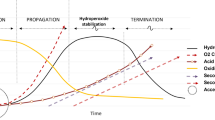Abstract
We aim at encapsulating fragrances made of a variety of lipophilic species to slow down their diffusion. Our strategy is to develop capsules by polymerizing the water intermediate phase of an oil-in-water-in-oil double emulsion. In other terms, our system consists in a direct emulsion of fragrance (O1) in a water phase (W) containing monomer, initiator, and cross-linker. To obtain the double emulsion, this direct emulsion, stabilized by a hydrophilic surfactant, is itself dispersed in an external lipophilic solvent used in perfumery (O2) and stabilized by a lipophilic surfactant. Polymerization of the intermediate water phase aims at obtaining a 3D network. Differently from nowadays-proposed capsules, this strategy allows polymerization only taking place in the water phase rather in the phase containing the fragrance. Moreover, the obtained 3D network is supposed to play the role of an effective barrier limiting the diffusion of the inner lipophilic species towards either the external solvent or air. Such an approach implies the combination of a formulation step to elaborate the double emulsion using two antagonistic surfactants, a hydrophilic one and a lipophilic one, and of the polymerization of the intermediate phase. Insertion of the polymerizable species in the double emulsion shall not destabilize it. Some monomers exhibiting interfacial affinity and interfering with the formulation of the double emulsion have to be avoided. By varying the nature of the monomers and the cross-linker to monomer ratio, capsules with high encapsulation efficiencies and with various mechanical properties have been obtained.

Graphical abstract














Similar content being viewed by others
References
Doane WM (1992) Encapsulation of pesticides in starch by extrusion. Ind Crop Prod 1(2–4):83–87. https://doi.org/10.1016/0926-6690(92)90004-F
Tsuiji K (2001) Microencapsulation of pesticides and their improved handling safety. J Microencapsul 18(2):137–147. https://doi.org/10.1080/026520401750063856
Zuidam, N.J. and V.A. Nedović, Encapsulation technologies for active food ingredients and food processing. Encapsulation Technologies for Active Food Ingredients and Food Processing 2010. 1–400
Nelson G (2002) Application of microencapsulation in textiles. Int J Pharm 242(1–2):55–62. https://doi.org/10.1016/S0378-5173(02)00141-2
Singh MN, Hemant KSY, Ram M, Shivakumar HG (2010) Microencapsulation: a promising technique for controlled drug delivery. Research in Pharmaceutical Sciences 5(2):65–77
Konuklu Y, Ostry M, Paksoy HO, Charvat P (2015) Review on using microencapsulated phase change materials (PCM) in building applications. Energy and Buildings 106:134–155. https://doi.org/10.1016/j.enbuild.2015.07.019
Warr, J., T. Ribaut, E. Aussant, O. Antony, and S. Fraser, New microcapsules 2013, Patent EP20130305075 (A2)
Warr, J., T. Ribaut, O. Anthony, and S. Fraser, Microcapsules, 2015, Patent EP2832442 (A1)
Warr, J., T. Ribaut, O. Anthony, and S. Fraser, Microcapsules, 2015, Patent EP2832441 (A1)
Warr, J., T. Ribaut, O. Anthony, and S. Fraser, Microcapsules, 2015, Patent EP2832440 (A1)
Jahns, E., D. Boeckh, W. Bertleff, and P. Neumann, Microcapsule preparations and detergents and cleaning agents containing microcapsules, 2005, Patent Brevet US 6951836 B2
Jahns, E. and B. Dames, Microcapsules, the production and use thereof, 1997, Patent Brevet US 5596051
Jacquemond M, Jeckelmann N, Ouali L, Haefliger OP (2009) Perfume-containing polyurea microcapsules with undetectable levels of free isocyanates. J Appl Polym Sci 114(5):3074–3080. https://doi.org/10.1002/app.30857
Kuo S-W, Kao H-C, Chang F-C (2003) Thermal behavior and specific interaction in high glass transition temperature PMMA copolymer. Polymer 44(22):6873–6882. https://doi.org/10.1016/j.polymer.2003.08.026
Bancroft, W.D., The theory of emulsification, V. The Journal of Physical Chemistry, 1913. 17(6): p. 501–519
Mabille C, Leal-Calderon F, Bibette J, Schmitt V (2003) Monodisperse fragmentation in emulsions: mechanisms and kinetics. Europhysics Letters (EPL) 61(5):708–714. https://doi.org/10.1209/epl/i2003-00133-6
Mabille C, Schmitt V, Gorria P, Leal Calderon F, Faye V, Deminière B, Bibette J (2000) Rheological and shearing conditions for the preparation of monodisperse emulsions. Langmuir 16(2):422–429. https://doi.org/10.1021/la990850w
Stasse M, Laurichesse E, Ribaut T, Anthony O, Héroguez V, Schmitt V (2020) Formulation of concentrated oil-in-water-in-oil double emulsions for fragrance encapsulation. Colloids Surf A Physicochem Eng Asp 592:124564
Nollet M, Laurichesse E, Besse S, Soubabère O, Schmitt V (2018) Determination of formulation conditions allowing double emulsions stabilized by PGPR and sodium caseinate to be used as capsules. Langmuir 34(8):2823–2833. https://doi.org/10.1021/acs.langmuir.7b04085
Taylor P (1998) Ostwald ripening in emulsions. Adv Colloid Interf Sci 75(2):107–163
Rodrigues SN, Martins IM, Fernandes IP, Gomes PB, Mata VG, Barreiro MF, Rodrigues AE (2009) Scentfashion®: Microencapsulated perfumes for textile application. Chemical Engineering Journal 149(1):463–472. https://doi.org/10.1016/j.cej.2009.02.021
Stasse M, Ribaut T, Schmitt V, Héroguez V (2019) Encapsulation of lipophilic fragrance by polymerization of the intermediate aqueous phase of an oil-in-water-in-oil (O/W/O) double emulsion. Polym Chem 10:4154–4162. https://doi.org/10.1039/C9PY00528E
Stasse, M., E. Laurichesse, M. Vandroux, T. Ribaut, V. Héroguez, and V. Schmitt, Cross-linking of double oil-in-water-in-oil emulsions: a powerful way to obtain microcapsules for with attractive mechanical properties, application to fragrance encapsulation. submitted
Acknowledgments
The authors would like to thank Olivier Anthony for fruitful discussions, Eric Laurichesse for his technical support, Maud Bassereau for her support in interpreting some GC chromatograms, and Takasago Europe Perfumery Laboratory for assembling the fragrances.
Funding
This study received financial support from the ANRT, Takasago Europe Perfumery Laboratory, CNRS, Université de Bordeaux, and INP (contract number 2014/1309).
Author information
Authors and Affiliations
Corresponding authors
Ethics declarations
Conflict of interest
The authors declare that they have no conflict of interest.
Additional information
Publisher’s note
Springer Nature remains neutral with regard to jurisdictional claims in published maps and institutional affiliations.
Electronic supplementary material
ESM 1
(DOCX 293 kb)
Rights and permissions
About this article
Cite this article
Stasse, M., Ribaut, T., Héroguez, V. et al. Elaboration of double emulsion-based polymeric capsules for fragrance. Colloid Polym Sci 299, 179–191 (2021). https://doi.org/10.1007/s00396-020-04702-8
Received:
Revised:
Accepted:
Published:
Issue Date:
DOI: https://doi.org/10.1007/s00396-020-04702-8




